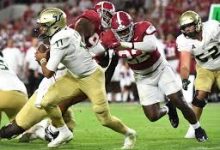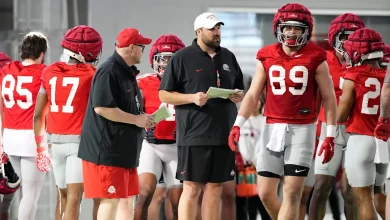Texas and Oklahoma’s athletic programs faced their first SEC season, with varying success in competition, recruiting, and adapting to new conference demands.

Texas and Oklahoma’s athletic programs faced their first SEC season, with varying success in competition, recruiting, and adapting to new conference demands.
The decision of Texas and Oklahoma to join the Southeastern Conference (SEC) marked one of the most significant realignments in college sports history. Announced in 2021 and officially set to take effect with the 2024 season, this move was driven by a combination of financial incentives, conference prestige, and ambitions for sustained athletic excellence. However, the transition into the SEC’s highly competitive landscape was complex, with each program experiencing distinct challenges and successes during their initial year in the conference.
This analysis explores how Texas and Oklahoma’s athletic programs fared during their SEC debut, examining their performance across multiple dimensions: on-field results, recruiting efforts, adaptation to new opponents and conference culture, coaching adjustments, fan engagement, and broader institutional impacts. While both schools share the goal of competing at the highest level, their initial SEC seasons revealed different trajectories, successes, and hurdles.
Context of the Move: Why Texas and Oklahoma Joined the SEC
Before delving into their first SEC season, it’s important to understand the context that prompted such a historic realignment.
Strategic Motivations
Financial Incentives: The SEC’s lucrative media rights deals and television contracts promise increased revenue streams for member schools.
Competitive Prestige: The SEC has established itself as the preeminent conference in college football, with numerous national championships and powerhouse programs.
Long-term Stability: The move aims to position Texas and Oklahoma among elite national contenders, ensuring their programs remain competitive and relevant.
Challenges of Transition
Scheduling and Rivalries: Adjusting to a new set of conference opponents, many of whom are traditional rivals or national title contenders.
Cultural Shift: Embracing the SEC’s physical, aggressive style of play and its intense, passionate fan base.
Operational Changes: Modifying recruiting strategies, coaching approaches, and logistical planning to meet SEC standards.
On-Field Performance in the SEC Debut Year
Texas Longhorns
Football Performance:
Record: Texas finished the 2024 season with a record that reflected the challenges of adjusting to SEC competition. Early season struggles included losses against established SEC powers, exposing gaps in depth and experience.
Key Games: The Longhorns faced stiff tests against traditional SEC giants such as Alabama and Georgia, suffering narrow losses but gaining valuable experience.
Offensive and Defensive Adjustments: Texas attempted to adapt their offensive scheme to SEC speed and physicality, emphasizing a balanced attack. Defense showed resilience but occasionally struggled against high-powered offenses.
Progress: Despite setbacks, Texas demonstrated significant growth over the course of the season, winning key conference games and showing flashes of the dominant play expected of SEC contenders.
Recruiting Impact:
The SEC debut invigorated Texas’s recruiting efforts, attracting top prospects eager to showcase their talent in one of college football’s toughest leagues.
Texas secured several high-profile commits during the season, signaling a positive trend toward replenishing talent pipelines.
Oklahoma Sooners
Football Performance:
Record: Oklahoma’s first SEC season was marked by a mixture of competitive games and some disappointing losses against top-tier SEC teams.
Key Matchups: The Sooners faced formidable opponents like LSU and Florida, with results highlighting areas for improvement but also moments of promise.
Playing Style: Oklahoma continued their traditional high-tempo, explosive offensive approach, which held up well against some defenses but faced challenges against SEC’s physicality.
Growth and Development: The team showed resilience, especially in close games, and improved over the course of the season, indicating a program adapting to the new conference environment.
Recruiting and Roster Development:
Oklahoma’s recruiting momentum in the SEC was mixed initially, with some top recruits excited about the conference switch but others cautious about increased competition.
The program prioritized adding SEC-specific defensive schemes to better handle the league’s physical offenses.
Challenges Faced During the Transition
Competition Level and Scheduling
The SEC’s depth and talent level posed significant challenges. Both Texas and Oklahoma faced an increased difficulty in scheduling, often playing multiple top-10 teams, which tested their depth, coaching, and resilience.
Physicality and Speed: The SEC’s emphasis on physical play and speed required adjustments in game planning and player development.
Increased Parity: The conference’s competitiveness meant that even traditionally weaker teams could upset higher-ranked programs, leading to unpredictable results.
Adaptation to Conference Culture
Intensified Rivalries: Texas and Oklahoma had to forge new rivalries and reconfigure traditional rivalries with teams like Arkansas, LSU, and Alabama.
Fan Expectations: The passionate SEC fan bases demanded high-intensity performances, creating a new environment that required mental toughness and strategic adaptability.
Coaching and Strategy Adjustments
Coaching staffs had to modify schemes, emphasize physical conditioning, and develop strategies tailored to SEC opponents. This involved more aggressive recruiting, focusing on SEC-style player profiles, and leveraging the unique strengths of their rosters.
Institutional and Logistical Challenges
Travel and Logistics: Increased travel demands, with longer trips to eastern and southern schools, impacted team routines and logistics.
Media and Branding: The schools increased media engagement efforts to capitalize on the SEC’s national exposure, which required resources and strategic planning.
Broader Impacts on Recruiting and Program Development
Recruiting Dynamics
Top Talent Attraction: The SEC’s reputation helped Texas and Oklahoma attract high-profile recruits, especially those eager to compete on the national stage.
Regional Recruiting: Both programs continued to focus on their traditional recruiting bases—Texas and Oklahoma—but now faced stiffer competition from SEC rivals.
Player Development and Depth
Increased Competition: The elevated level of play in the SEC pushed programs to develop deeper, more versatile rosters.
Transfer Portal: The first SEC season saw a surge in transfer portal activity, with players seeking opportunities in a more competitive environment.
Facilities and Investment
Both universities increased investments in facilities, training, and support staff to meet SEC standards, signaling commitment to sustained competitiveness.
Fan and Media Reactions
Fan Engagement
The initial SEC season was met with enthusiasm, increased media attention, and heightened expectations.
Some fans expressed optimism about future success, while others voiced concerns over immediate results and team performance.
Media Coverage
The SEC’s media partners highlighted Texas and Oklahoma’s transition challenges but also recognized their potential to become conference mainstays.
Analysts debated the impact of the move on college football’s landscape, emphasizing the importance of patience and long-term planning.
Long-Term Outlook and Future Prospects
Positives and Opportunities
Brand Elevation: Membership in the SEC enhances both programs’ national profiles.
Recruiting Boost: The conference’s prestige attracts top recruits seeking high-level competition.
Financial Benefits: Increased revenue streams support facilities, coaching, and player development.
Challenges to Overcome
Competitive Consistency: Achieving sustained success requires ongoing investment and strategic adjustments.
Cultural Integration: Fully embracing SEC culture and style of play is an ongoing process.
Building Rivalries: Developing intense, meaningful rivalries will help solidify their identity within the conference.
Long-Term Success Indicators
Future seasons will determine whether Texas and Oklahoma can rise to the top of the SEC standings.
Success will depend on coaching stability, recruiting classes, player development, and adaptability to conference demands.
A Promising but Challenging Start
In their inaugural SEC season, Texas and Oklahoma’s athletic programs demonstrated resilience, adaptation, and growth amid a highly competitive landscape. While both teams faced setbacks and challenges typical of such a significant transition, they also showcased potential and promise for future success.
Texas’s ability to recruit top talent, combined with its storied football tradition, positions it well for future SEC dominance. Oklahoma’s innovative offensive schemes and strong coaching staff provide a solid foundation to contend consistently.
The first SEC year was a foundational phase—marked by learning curves and adjustment struggles but also by opportunities for development and eventual supremacy. As the programs continue to evolve within the SEC’s demanding environment, sustained investment, strategic planning, and resilience will be essential to realize their ambitions of conference and national dominance.
The journey has just begun, and both Texas and Oklahoma are now integral parts of college football’s most competitive and exciting conference. Their first year in the SEC set the stage for future chapters of success, rivalry, and growth.









